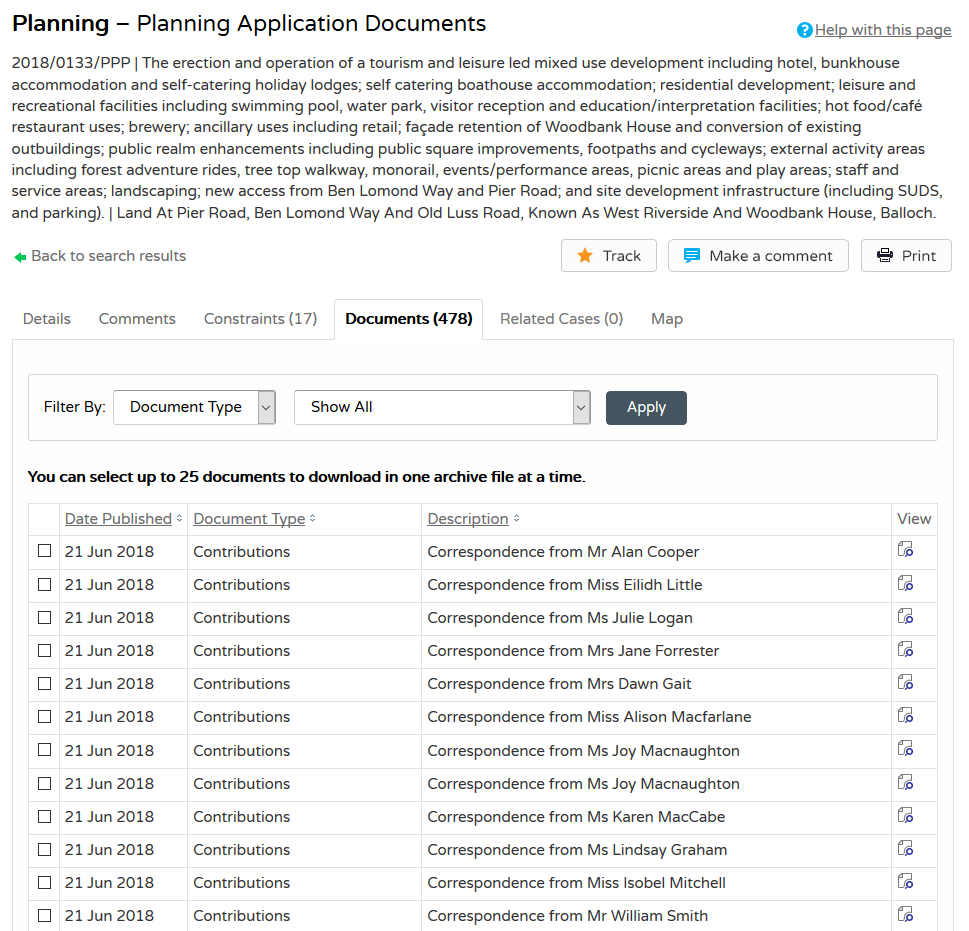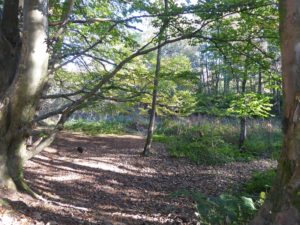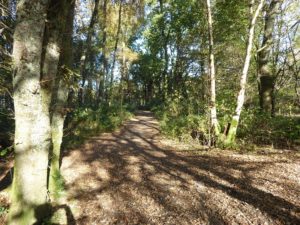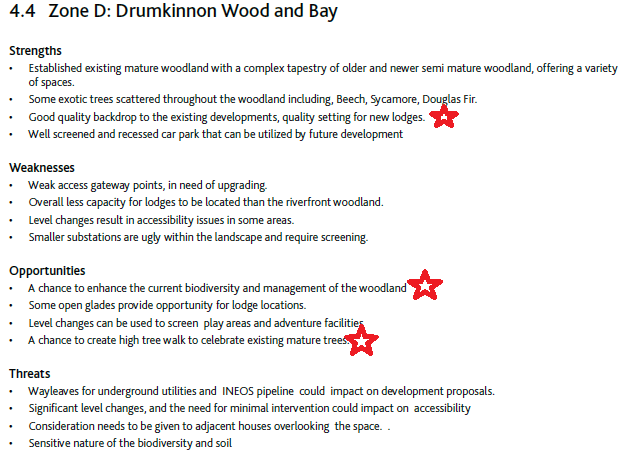The gulf between the rhetoric of the Scottish Establishment on the need for community involvement in planning and reality has created a massive crisis for the Flamingo Land Planning Application at Balloch. This post takes a look at people’s response to the Flamingo Land application, considers the key issues and the implications of what is going on both for the Planning Bill, currently being considered by the Scottish Government, and neo-liberal models of economic development which still rule how the Scottish Establishment thinks and behaves.
The objections to the Flamingo Land Planning Application
You would never know from looking at the Loch Lomond and Trossachs National Park Authority Planning Portal that, in the four weeks since the Flamingo Land Application appeared (see here), there have been almost 400 objection to the Flamingo Land consultation:

The vast majority of the 478 documents now on the LLTNPA Planning Portal are objections but you cannot tell this just from looking at the Portal as, without exception, they are classified as a Contribution and then described as “Correspondence”. The planning portal software, however, allows all contributions to be classified as SUPPORT or OBJECTION as this extract from the Cairngorms National Park planning portal shows:

So why has the LLTNPA, a self-proclaimed beacon of planning excellence, not classified all the contributions its received to date as Objections or Support like the CNPA? It appears the LLTNPA wants to make it as difficult as possible for the public and the media to understand what is going on.
The local public consultation held by the Community Council
The Balloch and Haldane Community Council held a local consultation event a week ago on the Planning Application. It was a packed meeting, with 167 local people apparently attending, although Gordon Watson, Chief Executive of the LLTNPA, Scottish Enterprise and Flamingo Land all gave their apologies. The locally elected LLTNPA Board Member, David McCowan, and West Dunbartonshire representative on the Board, Councillor Diane Docherty, however, were both there as were local councillors, Jonathan McColl (who is the SNP Leader of the West Dunbartonshire Council) and Sally Page (Conservative and Unionist) .
The reports I have had from people who attended the meeting is that 35 to 40 people spoke about the Planning Application and there was not a single voice in favour. In other words there is now massive opposition locally to Flamingo Land and my informants reported that the locally elected representatives present were visibly shocked by the strength of feeling. A report on Commonspace (see here) – the mainstream media are still to report on what is going on – also confirmed what my informants told me, that Jonathan McColl, the WDC SNP Council Leader, said at the end of the meeting he had totally changed his view about Flamingo Land since listening to the passionate and well articulated objections. (Since writing this I have learned there has been extensive coverage in the Daily Record (see here).
Whether this leads to West Dunbartonshire Council opposing the application – this would be an ideal opportunity for local SNP councillors to demonstrate they are capable of standing up against the Scottish Government – or whether the Balloch and Haldane Community Council, which had previously supported the development of the Riverside Site, now lodges an objection remains to be seen. One local elected representative has, however, lodged an objection to the application:

Counclllor Bollan is from the West Dunbartonshire Community Party.
Planning and democracy – the gulf between rhetoric and reality
My own local community was, like Balloch, a year or so ago involved in a community planning event – a charrette – at the end of which our local MSP, who just so happens to be Nicola Sturgeon, spoke passionately about the need for local communities to drive planning processes. The Scottish Government consultation “Places, People and Planning” which was supposed to be all about involving people in creating better places and making economic development more sustainable transmogrified into a Planning Bill which would give even more power to developers. The nub of the problem is that while the Scottish Establishment sees economic development as their top priority – rightly some of them want to see new jobs – they believe only private enterprise can deliver this and that any constraints on private business (whether through tax or the planning system) will drive investment elsewhere.
The consequence is we end up with tick box planning exercises in which any old development, even in National Parks, is dressed up to appear as “sustainable” and as “meeting the needs of local communities”. The Cononish gold mine is a case in point (see here). The truth is that the Scottish Establishment, including the LLTNPA Board and senior management team, have not a clue about what sustainable economic development would look like and, what’s worse, are not prepared to hand over real power to local communities to decide this for themselves. Flamingo Land provides a perfect example of all that is going wrong.
After Scottish Enterprise acquired the site, their first major proposal was to use it for housing – that would have achieved maximum sale value – but this was defeated not least by opposition from the Friends of Loch Lomond and Trossachs who rightly thought that the shores of Loch Lomond and the River Leven should not be covered by a housing development. The site was then earmarked for recreational and leisure development in the LLTNPA’s Local Development Plan. This is all in line with the Scottish Government wanting to put more emphasis on Local Development Plans with the idea being that once something has been agreed as part of a Local Development Plan it should go ahead with as few constraints as possible. The problem is that earmarking land in the Local Development for recreation and leisure could mean anything, from low intensity development to Flamingo Land’s 125 or so holiday lodges, hotels and leisure complex: what has happened at Balloch shows is that until people actually see what is being proposed they don’t object. The whole idea therefore -that vague allocations of space in Local Development Plans should be the be all and end all of the planning system is therefore fundamentally flawed.
The LLTNPA, Scottish Enterprise and the Scottish Government, however, took the lack of objections to the Local Development Plan as a green light to push ahead with intensive development of the Riverside site all the while advising the local community NOT to comment or object until they saw exactly what was being proposed. Meantime the LLTNPA was on the interview panel which selected Flamingo Land as the preferred developer of the site – determining the type of development that would be proposed – while the LLTNPA and Scottish Government included development of the Riverside Site as one of its key performance indicators for the National Park’s Partnership Plan. None of this is accidental – Petra Biberbach, Convener of the LLTNPA Planning Committee, was one of the three authors of the review of the planning system which led to the current Planning Bill – but it most certainly prejudices the whole planning process..
That such a gulf has developed between the local community and others who care about our National Parks and our public authorities over Flamingo Land should give the Scottish Parliament all the evidence they need about why the processes being proposed in the Planning Bill are so flawed.
The ideological gulf between developers and planners and the public
I have looked through quite a few of the objections to the Flamingo Land Planning Application. They vary from just a sentence to detailed critiques (within the context that the number of words that can be submitted online are strictly limited). What most objectors have in common however is a belief that nature is very important to people and an understanding that National Parks should be special places. Here is one example:
Comment:As a frequent visitor to the area this proposed development is an outrage. Not only will it
destroy a vast area of natural beauty,tranquility and a historic part of Scotland but it will also
impact greatly on this areas infrastructure. People visit Loch Lomond to enjoy what it has to offer
at the moment,to destroy that and replace it with a glorified funfare will certainly act as a deterrent
to so many existing and potential visitors. This area deserves to be protected not exploited. Once
it has been destroyed we can never get it back.
The LLTNPA is likely to depict such objections as rants which they will contrast with the “measured” “assessments” of professionals but the real contrast, I believe, is between the public’s understanding of the importance of nature and the planning speak which is being used to justify the development proposals. Take Drumkinnon Wood, which is tucked behind Lomond Shores:

 and then compare what is on offer at present from Flamingo Land:
and then compare what is on offer at present from Flamingo Land:
People aren’t stupid, this is complete and utter crap:
- There is no reference to who uses the woods at present of what they think about it – local people love to walk there – but instead they are a “quality setting for new lodges”.
- Instead quiet enjoyment of the wood from the ground is to be replaced by a high tree walk which will “celebrate existing mature trees”
- And somehow, despite the Lodges, which will destroy lots of the ground vegetation and remove lots of trees, and the tree top walkway there is a “chance” to enhance biodiversity.
I am reminded of the LLTNPA’s claims that 450,000 tonnes of spoil from the Cononish goldmine will improve the natural landscape and area of wild land………………
And if you are still not convinced of the gulf between development speak and reality read the Transport Assessment – all eight documents. Lots of sophisticated models predicting a tiny percentage increase in traffic in Balloch but which totally misses the point: the place is gridlocked most holiday weekends, local residents and visitors unable to move, but despite those facts Flamingo Land wants to provide for and therefore attract more cars to the place.
Its no wonder local people are up in arms.
The Way Forward
The Riverside Site is all publicly owned land (though Flamingo Land does own the land around Woodbank House). If the Scottish Government can give the tiny community on the isle of Ulva over £4m to buy their island, they can invite the people of Balloch to set up their own Community Trust and then instruct Scottish Enterprise to gift it the Riverside Site on the condition its maintained in community and public ownership for all time. That would then enable a bottom up planning process which I believe would result in “sustainable” economic development rather than the current model of development at any price.
Our Public Authorities need to be brave enough to admit they have got it totally wrong at Balloch, compensate Flamingo Land for any expenses they have incurred and re-start the planning process.
Any proposals for the site should, I believe, start by looking at what areas would be important to retain in a natural state/keep free of development because of their importance to the local community and to the wider public. Drumkinnon Wood is the obvious example but I suspect there would be strong cases made for other areas. Instead of a single intensive development there would be low intensity developments. The local community might then decide to keep or adapt some of Flamingo Land’s proposals – for example a number of holiday lodges accessed by foot or a walkers/cyclists hostel – while ditching other elements and coming up with ideas of their own . That might then help create a National Park worthy of the name.

Woodside House, would that be Woodbank House the category A listed Georgian Mansion House of National Importance?
Thanks for picking this up David, brain not functioning properly and have corrected; worth looking at plans for that too, Nick
Sorry Nick I get lost in much of what you write. So I have read the above in the fear of dozin off!
We all appreciate that people have the right to object of course however look at the facts be it right or wrong they are facts.
Land acquired by Dumbartonshire enterprise in the 80’s as the local community wanted it safeguarded for tourism and leisure.
Dumbartonshire enterprise becomes SE.
The start of the land development happens in the late 1990,s with LLS opening in the early 2000’s with the promise of phase 2 accommodation and link to Balloch.
Property developer comes along wants to buy all the land for housing but again local objection no the land is for tourism development but agreement is made at what is Drumkinnon gate was sold.
The economy hits hard times no one comes forward through 2007 to 2015 when another attempt is made. The advertising says we are looking for developers to come forward. The brief is for holiday lodges activities link to Balloch hotels budget accommodation etc. Iconic leisure bids and are successful. During this time the land is adopted by the locals in the local development plan and signed by Scottish government! Again for tourism and leisure.
The planning process starts and we are surprised!!! Further more we are surprised at what’s being proposed when in fact for 40 years we have been asking for leisure and tourism Come on!! I was involved in trying no to buy the land in early 2000’s I live locally am I the only one in the area that knew this! Surely not.
So my question to you given you seem to a have an opinion on everything why are you so surprised by an application? Where were you when it mattered? In the 80’s then again in the 90’s and yes again in early 2000’s and finally in 2015? How many opertunitues. Would it not have made better sense to get up and make your point then! No let’s wait until for the 1st time someone gets close to making a difference to a dying economy.
Wake up!!!
Hi Andy, in answer to your questions a few years ago I was doing other things………….but the point of my blog piece was precisely to ask the question why is it that our Planning Authorities and Public Agencies tick all the boxes in terms of process (and you have added more relevant information about this) but then what they come up finally meets extensive local opposition. I was trying to raise the question what is it about these processes that results in things going so badly wrong. Would be interesting to know your views on this but I think part of the explanation is that the end development being proposed by Flamingo Land does not meet local aspirations, eg there is no bridge being proposed over the River Leven (an idea that also goes back over thirty years I understand). Nick
I see the point of this post has whizzed over Andy Miller’s head. Regarding the manner in which the calls for developers were advertised, and the subsequent consultation processes that were embarked upon: the very existence of overwhelming local opposition demonstrates the inadequacy of efforts made in this respect. You mock the fact that local people are surprised. Well I’ll tell you what: they wouldn’t be surprised, and you wouldn’t be surprised that they’re surprised, had an adequate consultation process been put in place. It wasn’t; it was thoroughly and manifestly inadequate in ways too numerous to detail here. So late in the day you’re left with the bottom line: people don’t want this.
In the 80’s I was in primary School, in the 90’s High School. Following that college in the 2000’s. 2015 found me in Glasgow and completely unaware that part of our Scottish NATIONAL park was for sale as is the case for most people all across Scotland, whom this also affects.
The facts of the matter are the use of this land has changed organically over this time with the community locally and visitors from elsewhere making extensive use of it for outdoor leisure activities. One of the prime objectives the Natuonal Park are there to promote & protect.
So when it comes to the land being for sale for ‘Leisure and Tourism’ opportunities….. the land has already been adopted for leisure opportunities without the need of being sold to a private developer. It is the ‘tourism’ aspect of the proposed development, or more specifically the accommodations proposed, that now threatens the exisitng leisure use of the land and is of concern locally and nationally.
Whilst I take on board the comments regarding the ‘sale’ history of the land. It is the CURRENT use and needs of the Park, local community and visitor needs that now need to be addressed.
To make this sale base on a past decision regarding what its use should be, is illogical and very concerning for the National Park.